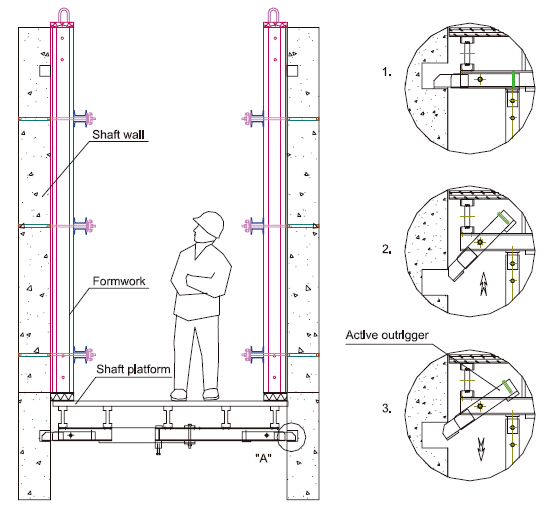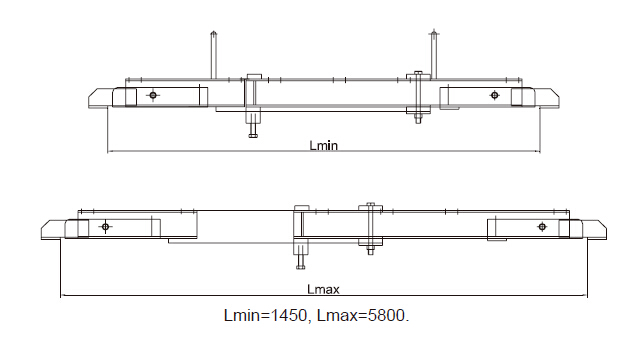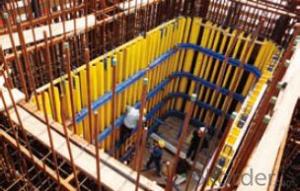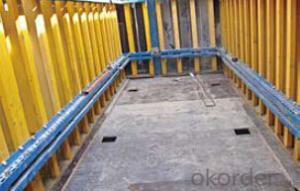Shaft-platform System for Formwork and Scaffolding
- Loading Port:
- Tianjin
- Payment Terms:
- TT OR LC
- Min Order Qty:
- 50 m²
- Supply Capability:
- 1000 m²/month
OKorder Service Pledge
Quality Product, Order Online Tracking, Timely Delivery
OKorder Financial Service
Credit Rating, Credit Services, Credit Purchasing
You Might Also Like
Shaft Platform
As operating platform, the shaft platform is mainly used in the concrete pouring of elevator shaft,
equipment shaft, stair shaft of high-rise building and so on.
Characteristics:
◆ The length of shaft beam is adjustable.
◆ Flexible structure makes lifting easier.


- Q:Can steel formwork be used for structures with high fire resistance requirements?
- Yes, steel formwork can be used for structures with high fire resistance requirements. Steel is known for its excellent fire resistance properties, as it does not burn or contribute to the spread of fire. Steel formwork can withstand high temperatures and maintain its structural integrity, making it suitable for use in fire-resistant structures.
- Q:Are there any specific building codes or regulations related to steel formwork?
- Yes, there are specific building codes and regulations related to steel formwork. These codes and regulations vary by country and region, but they generally cover aspects such as design, construction, installation, and safety requirements for steel formwork systems. These regulations ensure that steel formwork structures meet the necessary standards for strength, stability, and durability, while also addressing issues such as fire resistance, load capacity, and worker safety. Compliance with these codes and regulations is crucial to ensure the successful and safe use of steel formwork in construction projects.
- Q:How does steel formwork contribute to the overall accuracy of concrete placement?
- Steel formwork contributes to the overall accuracy of concrete placement in several ways. First and foremost, steel formwork provides a rigid and stable structure that ensures the concrete is poured and cured in the desired shape and dimensions. The steel panels are designed to be strong and resistant to deformation, which minimizes the risk of the formwork shifting or warping during the pouring process. Furthermore, steel formwork allows for precise control over the alignment and leveling of the formwork. The panels can be easily adjusted and secured in place, ensuring that the concrete is poured at the intended level and alignment. This is particularly important for projects that require a high level of accuracy, such as those involving intricate architectural designs or where precise measurements are critical. Additionally, steel formwork offers the advantage of reusability. Unlike traditional wooden formwork, which can only be used a limited number of times, steel formwork can be used repeatedly without compromising its structural integrity. This reusability factor contributes to cost-effectiveness and allows for consistent accuracy in concrete placement throughout multiple projects. Moreover, the smooth surface of steel formwork helps to achieve a high-quality finish on the concrete surface. The smoothness of the steel panels minimizes the risk of surface imperfections and ensures a consistent texture and appearance. This is particularly important for projects where the concrete will be left exposed, such as architectural features or decorative elements. In conclusion, steel formwork plays a crucial role in ensuring the overall accuracy of concrete placement. Its rigidity, adjustability, reusability, and smooth surface contribute to achieving precise dimensions, alignment, and finish, making it an indispensable tool for construction projects that require high levels of accuracy and quality.
- Q:Is steel formwork more durable than other types of formwork?
- Steel formwork is indeed more durable than other types of formwork. Steel is a strong and sturdy material that can withstand heavy loads and high pressures. It is highly resistant to wear and tear, making it ideal for construction projects that require repetitive use of formwork. Unlike other materials such as wood or plastic, steel formwork does not warp, crack, or deteriorate easily over time. This durability ensures that steel formwork can be used for multiple concrete pours, reducing the need for frequent replacements and saving costs in the long run. Additionally, steel formwork is fire-resistant, which further enhances its durability and safety features. Overall, steel formwork offers superior durability compared to other types of formwork and is a reliable choice for construction projects.
- Q:How does steel formwork prevent concrete segregation during pouring?
- Steel formwork prevents concrete segregation during pouring by providing strong and rigid support to the concrete mixture. It holds the concrete in place, preventing it from separating into its individual components, such as sand, aggregates, and cement. The steel formwork also helps in controlling the flow of concrete, ensuring that it is evenly distributed throughout the structure, reducing the chances of segregation.
- Q:Can steel formwork be used for staircases and ramps?
- Steel formwork is indeed capable of being utilized for the construction of staircases and ramps. It possesses a great deal of versatility and durability, making it an ideal choice for the creation of intricate shapes and structures. The strength and stability that it offers are essential for supporting the weight and loadings associated with staircases and ramps. Moreover, the assembly and disassembly of steel formwork can be accomplished with ease, allowing for efficient construction and customization of staircases and ramps. Its flexibility enables the creation of diverse designs and sizes that cater specifically to the requirements of a given project. In conclusion, when considering the construction of staircases and ramps, the use of steel formwork is highly suitable due to its strength, durability, versatility, and user-friendly nature.
- Q:Can steel formwork be easily modified or adjusted during concrete placement?
- Concrete placement can easily incorporate modifications or adjustments when using steel formwork. The versatility and flexibility of steel formwork enable effortless modifications or adjustments according to the needs of the concrete structure. Steel formwork systems typically consist of adjustable components like panels, beams, and props, which can be readily repositioned or relocated to accommodate changes in the design or dimensions of the concrete structure. These adjustable components can be swiftly and securely locked in place, ensuring stability and support during concrete placement. Moreover, steel formwork facilitates the utilization of various formwork accessories like clamps, connectors, and ties, further enhancing its adaptability and ease of modification. In summary, steel formwork offers a highly efficient and flexible solution for adjusting or modifying formwork during concrete placement.
- Q:What are the different types of steel formwork supports?
- There are several different types of steel formwork supports that are commonly used in construction projects. Some of the main types include: 1. Adjustable Steel Props: These are vertical supports that can be adjusted to desired heights. They are made of steel tubes with an adjustable inner and outer tube, allowing for easy height adjustment. Adjustable steel props are commonly used to support horizontal formwork or scaffolding systems. 2. Soldier Formwork System: This type of steel formwork support consists of vertical steel members known as soldiers that are spaced at regular intervals along the formwork. Soldiers are designed to resist the lateral pressure of wet concrete and provide support to the formwork panels. 3. Trench Struts: Trench struts are used to support and stabilize formwork in trenches or excavations. They consist of steel tubes with adjustable length and are typically used in conjunction with steel walers or beams to create a sturdy framework for the formwork. 4. H-Frame Systems: H-frame systems are commonly used for vertical formwork supports. They consist of steel frames in the shape of an "H" that are connected together to create a stable structure. H-frame systems are often used for supporting vertical formwork panels or as a framework for climbing formwork systems. 5. Steel Waler: A steel waler is a horizontal member used to support the formwork panels. It is typically made of steel channels or beams and is used in conjunction with vertical supports like adjustable steel props or trench struts. These are just a few examples of the different types of steel formwork supports that are commonly used in construction. The choice of support system depends on the specific requirements of the project, such as the formwork design, load capacity, and desired adjustability.
- Q:How is steel formwork used in construction projects?
- Steel formwork is a widely used construction technique that involves the use of steel panels and frames to create temporary molds or formworks. These formworks are used to shape and support wet concrete until it sets and hardens into the desired structure. In construction projects, steel formwork is primarily used for large-scale projects such as high-rise buildings, bridges, and dams. The use of steel formwork offers several advantages over traditional timber formwork, including increased strength, durability, and reusability. To use steel formwork, the first step is to design and fabricate the steel panels and frames according to the specific project requirements. These panels are typically made of high-quality steel, which makes them strong enough to withstand the weight and pressure of wet concrete. Once the steel formwork is fabricated, it is transported to the construction site and assembled by skilled workers. The panels are joined together using various connecting methods such as clamps or bolts to create a sturdy framework. This framework acts as a mold, providing support and containment for the wet concrete. The steel formwork is then carefully positioned and aligned in accordance with the project plans. Reinforcement bars, also known as rebars, are often placed within the formwork to add strength to the final structure. Once everything is in place, the concrete is poured into the formwork, filling up the designated areas. During the curing process, the steel formwork plays a crucial role in ensuring the concrete retains its shape and strength. The steel panels prevent the concrete from bulging or deforming under its own weight, resulting in a high-quality and structurally sound finished product. Once the concrete has hardened and gained enough strength, the steel formwork can be removed. Due to its durability and reusability, the steel formwork can be disassembled and used in multiple construction projects, making it a cost-effective and sustainable option. In conclusion, steel formwork is an essential component in construction projects as it provides a reliable and efficient method for shaping and supporting wet concrete. Its strength, durability, and reusability make it a popular choice for large-scale projects, ensuring the successful completion of various structures.
- Q:What are the common design considerations for steel formwork in high-rise construction?
- High-rise construction necessitates careful evaluation of several design considerations for steel formwork. First and foremost, it is crucial to assess the load-bearing capacity of the formwork. Heavy loads, including concrete weight, equipment, and workers, are common in high-rise constructions. Thus, the steel formwork must be designed to withstand these loads and prioritize construction safety. Durability and longevity are also key factors to consider. High-rise construction projects often span months or even years, necessitating formwork that can endure prolonged use and exposure to diverse weather conditions. Steel formwork is preferred for its strength and resistance to wear and tear. Additionally, the formwork design should prioritize ease of assembly and disassembly. Frequent repositioning of the formwork during the building process is common in high-rise construction projects. Consequently, the formwork system should enable efficient and swift assembly and disassembly, minimizing downtime and boosting productivity. Flexibility and adaptability are crucial in the formwork design for high-rise construction. The formwork must be capable of accommodating various shapes and sizes of concrete elements, such as columns, walls, and slabs. This necessitates a well-designed formwork system that can be easily adjusted and modified to meet specific requirements in each construction phase. Safety is of paramount importance in high-rise construction. The formwork design should incorporate appropriate safety features, such as handrails, guardrails, and non-slip surfaces, to prevent accidents and ensure worker well-being. Lastly, cost-effectiveness is a significant consideration. High-rise construction projects can be financially demanding, and the formwork design should aim to minimize material and labor costs without compromising quality and safety. In conclusion, the design considerations for steel formwork in high-rise construction encompass load-bearing capacity, durability, ease of assembly and disassembly, flexibility, safety, and cost-effectiveness. By addressing these factors, engineers and designers can ensure successful and efficient execution of high-rise construction projects.
1. Manufacturer Overview |
|
|---|---|
| Location | |
| Year Established | |
| Annual Output Value | |
| Main Markets | |
| Company Certifications | |
2. Manufacturer Certificates |
|
|---|---|
| a) Certification Name | |
| Range | |
| Reference | |
| Validity Period | |
3. Manufacturer Capability |
|
|---|---|
| a)Trade Capacity | |
| Nearest Port | |
| Export Percentage | |
| No.of Employees in Trade Department | |
| Language Spoken: | |
| b)Factory Information | |
| Factory Size: | |
| No. of Production Lines | |
| Contract Manufacturing | |
| Product Price Range | |
Send your message to us
Shaft-platform System for Formwork and Scaffolding
- Loading Port:
- Tianjin
- Payment Terms:
- TT OR LC
- Min Order Qty:
- 50 m²
- Supply Capability:
- 1000 m²/month
OKorder Service Pledge
Quality Product, Order Online Tracking, Timely Delivery
OKorder Financial Service
Credit Rating, Credit Services, Credit Purchasing
Similar products
New products
Hot products
Related keywords
























